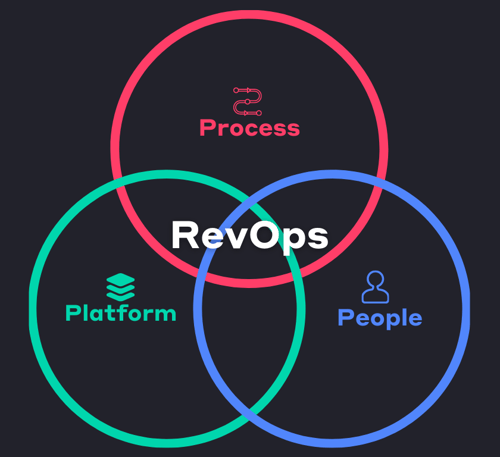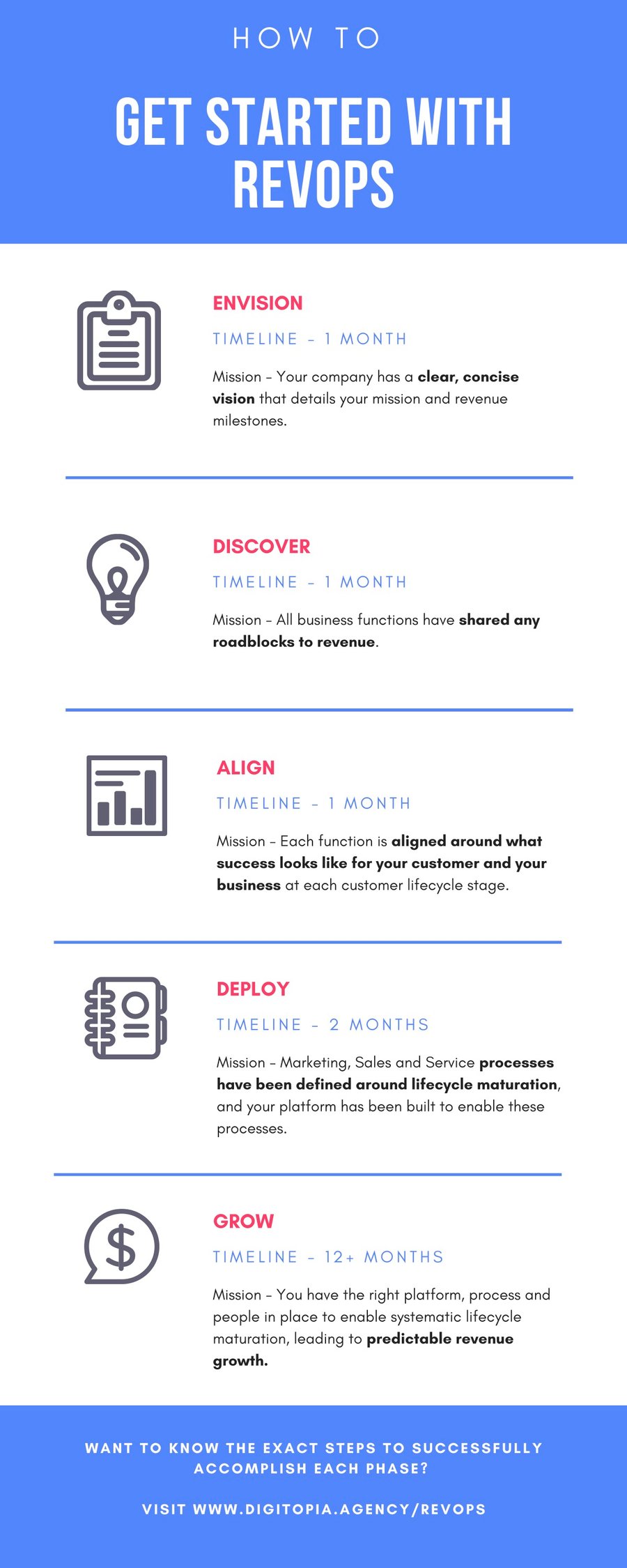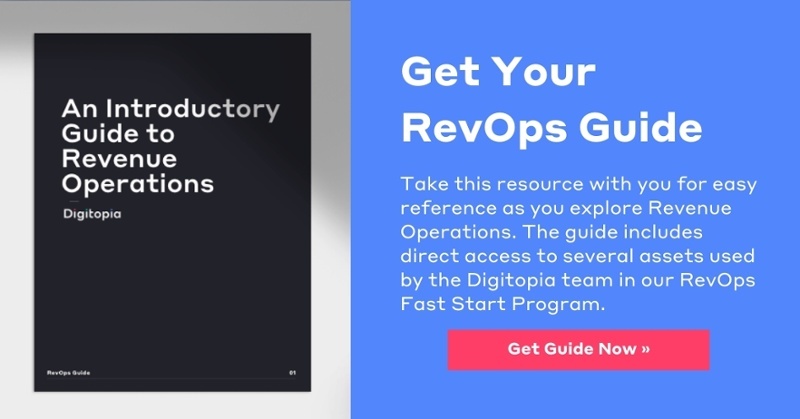How to Start RevOps? A Guide to Integrating Revenue Operations
by DJ Shirley | Updated Nov 5, 2021
Revenue Operations (RevOps) is an up and coming business function in the B2B operations realm. For years alignment between marketing, sales, and service teams has been the key issue highlighted by thought leaders and B2B growth experts. By fostering alignment, you can shift the paradigm within an organization from “us” to “we”.
This subtle shift between teams looking at the entire organization’s revenue engine versus just a lens on what their specific department directly impacts is transformational. Companies able to crack this code and achieve alignment can scale successfully and recognize their true revenue potential.
Revenue Operations is a framework that enables you to foster alignment across your customer journey, your data, and most importantly, your internal teams.

Chance are, if you are reading this article, you understand the core framework of Revenue Operations and its potential impact on your business, but a key question remains…
...how do I start Revenue Operations and what does a successful implementation process actually look like?
This spirals into a number of supporting questions...- What commitments do you need to make to ensure a successful adoption into your company?
- What resources are you going to need?
- How long is the integration and adoption process going to take?
As with any new integration, you need to make sure you and your team are ready and have accurate expectations.
Outlined below are several essential factors you need to consider when exploring the possibility of integrating RevOps into your organization. If you cannot allocate the required time and resources to the integration process, it will fail, or the benefits will be minimal if not non-existent.
Simple RevOps Readiness Test:
Ready:
Are you growing or poised to grow in the near future but recognize your time will be further limited to support the infrastructure needed to scale? If yes, RevOps is a smart play and will help you build the infrastructure needed to support growth while continually optimizing for efficiency.
Not Ready:
Are you nervous about keeping the doors open next month because you need more sales tomorrow? If yes, RevOps can wait while you laser in on getting the sales needed to stabilize. RevOps will not be the silver bullet that magically aligns your organization and quickly turn your sales department into a well-oiled machine.
If you are in the “Ready”, then you can move forward in your exploration of activating Revenue Operations.
The infographic below provides an overview of the steps to activate revenue operations along with a general timeline. Further below is an outline of the assets organizations have found helpful as they begin the integration process. Lastly, you'll find commitments to consider in regard to responsibilities and bandwidth across key positions needed to support a successful integration.

Needed Criteria to Successfully Activate RevOps
Before jumping into how you activate Revenue Operations in your company, you need to confirm you have the needed assets to help anchor the integration.
You must have the company’s mission summarized and your core buyer personas outlined. These may seem like fundamental documents, but you'd be surprised how often these crucial assets are buried somewhere in the archives or only visited at a certain level within the organization.
Why are these assets essential to the process? RevOps helps to galvanize the entire team around the company's mission and focuses efforts on growing the company's revenue pipeline. If everybody is not operating off the same playbook, there will always be misalignment and friction.
If you have these documents established and accessible to the entire organization, you are ready to take the next step.
Needed Time to Successfully Activate RevOps
So how much time do you need to commit when integrating RevOps into your organization to see the benefits?
On average, with a dedicated individual leading the RevOps integration and a committed team. You can start to see benefits as early as 60 days within your organization. At the end of the 60 days integration process, you will have:
- An in-depth understanding of your internal business metrics
- A single source of truth that defines the different lifecycle stages of your customers and their handoff points between your departments
- A 12-month RevOps Growth Roadmap designed to address and solve the biggest bottleneck(s) blocking your organization's growth potential.
These first actions will guide your company forward and makes a common practice of bottleneck identification, streamlined process management, and product/service optimization. Additionally, actionable business intelligence dashboards will highlight and validate the areas generating revenue and call attention to areas either bleeding or leaving untapped revenue on the table.
As with activating a new employee or adopting a new platform, there will be a learning curve. Additional time is needed at the start of the engagement to embrace and understand the process. The first few months in the adoption process are vital when onboarding Revenue Operations. A significant milestone is helping everyone understand how their department and individual efforts impact the company's revenue pipeline.
Additionally, you will need buy-in and participation from your marketing, sales, and customer service/product teams. Each department should join a joint RevOps meeting to allow department leads to report on the bottlenecks they face and better understand bottlenecks within other departments they can potentially support.
Next Steps When Activating RevOps:
If you meet the needed criteria and time commitments for activating RevOps, it’s time to identify your RevOps Champion. The individual who is going to lead the charge and be responsible for leading the implementation process of RevOps in your business.
There are several methods to source a RevOps champion in your organization. The best solution for you is highly dependent on variables such as your company size, org structure, industry, sales cycle, tech stacks, and more. Here are the 3 most common avenues for sourcing a RevOps champion.
RevOps Champion Sources:
- Delegate and assign RevOps responsibilities among your existing team -Common among organizations with less than 15 employees
- Activate a 3rd party to guide the implementation process in your company - Common among organizations with 15+ employees
- Hire a full-time team member dedicated to RevOps from outside the organization - Common among organizations with 50+ employees.
(The budget needed to bring on a full-time RevOps employee and the supporting budget required to enable the role to operate successfully is substantial and rare for growing organizations under 50 employees.)
Once you have your RevOps champion in place, you can begin to map out the technical phases of activating RevOps in your company. Depending on your business model and current organization structure, your champion will need to identify the RevOps Pillar you need to first address: Process, Platform, or People.
If you are not sure where to start, you can explore our RevOps Strategy & Dashboard solution. Or, get a copy of Digitopia's Introductory Guide to Revenue Operations for quick reference in the future.









